FOCUSING ON A CENTRALIZED DESIGN
When developing the CATALYST platform, Arctic Cat engineers kept stringent focus on Centralized Designs to ensure the high-performance platform reacts quicker to the rider’s input and body english. What’s that mean for us? We get a platform requiring less effort to corner, carve and throw around – Ultimately improving our rider skills. Hooray! The below information is a broader look at the overall CATALYST platform. In the coming weeks, Ill dig down further into each of these categories to share details. -Kale
So, where did engineers focus attention?
- Having a low center of gravity is key and they focused on starting down low in the middle and placing heavier components in a centralized location with lighter components on the exterior.
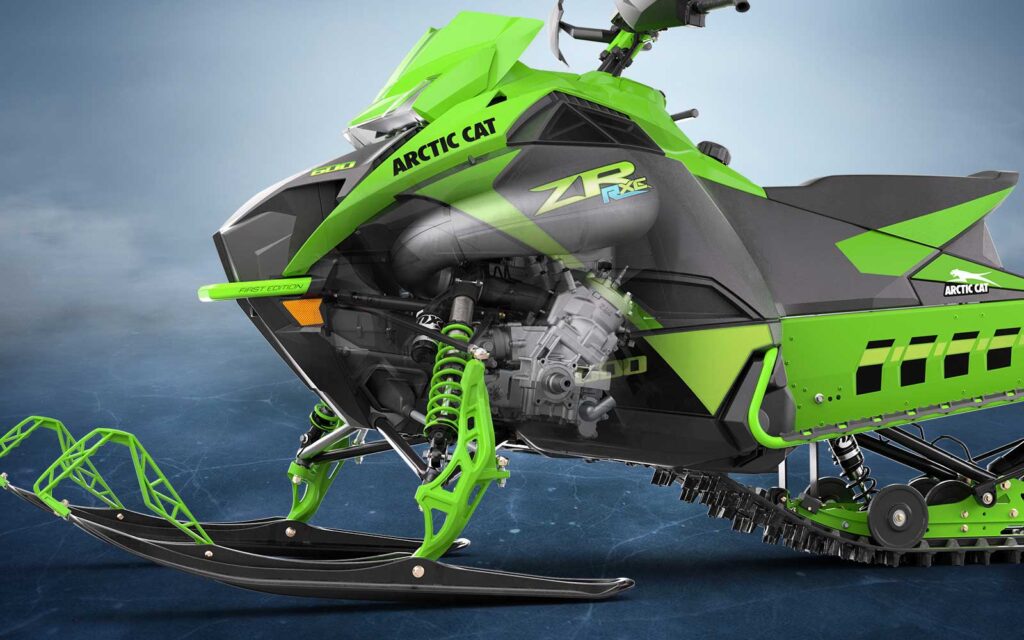
- At the heart of the narrow, tightly compact and completely balanced platform, features Arctic Cat’s exclusive laydown engine design, the C-TEC2 600, 2-stroke. This is one of my favorite engines and its 125-class horsepower is highly reliable. More details will come on all the engine changes, but the compact design is lighter with stainless-steel exhaust and the airbox is located up front.
- Introduced on 2022 models, the benefits of the ADAPT CVT System enhance the lightweight centralized design focus of the CATALYST platform. Lighter than previous CVT systems before it, ADAPT has a 5% reduction in inertia and its compact width is perfectly paired to the all-new body panels which are narrower and sleeker than the Procross GEN II bodywork.
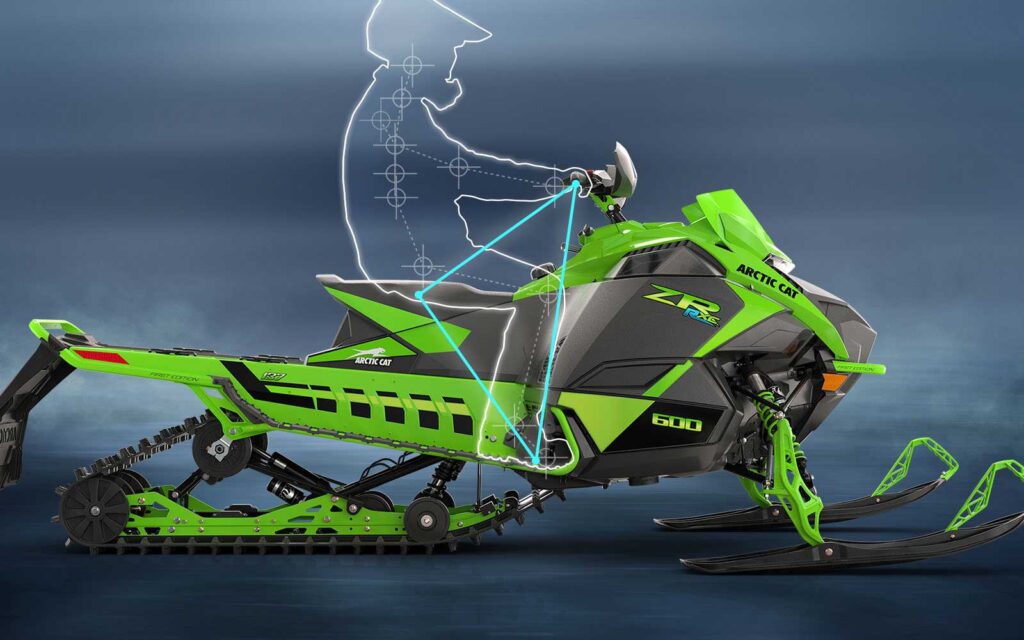
- The CATALYST platform is loaded with attention to rider balance details the majority of us don’t think about like gas tanks and the fuel they hold. Engineers spent time optimizing the shape of the 10.4-gallon gas tank to keep weight centralized and enhance rider ergonomics, but they went many steps further to maintain constant fuel pick-up and equal out platform balance by decreasing the amount of fuel sloshing for a variety of riding styles and applications.
When you think about all the quick accelerations, firm braking and ride angles a snowmobile is subjected to both on the trail, and off, a traditional flat bottom fuel tank is sloshing its gasoline from side-to-side and front-to-back thousands of times with a fair amount of force. I love their attention to these details!
DRASTIC WEIGHT REDUCTION
IMO, I don’t see any detractors of having a lightweight snowmobile unless it ultimately takes away from durability. Arctic Cat has done a great job of reducing incremental weight over the timespan of their ProCross/ProClimb trail and mountain platforms, and seemingly figured out a near perfect mix of lightweight vs sacrificing durability. That said, they kept weight loss at the forefront of the CATALYST design process resulting in a drastic 10% weight reduction for new Trail, Crossover and Mountain models.
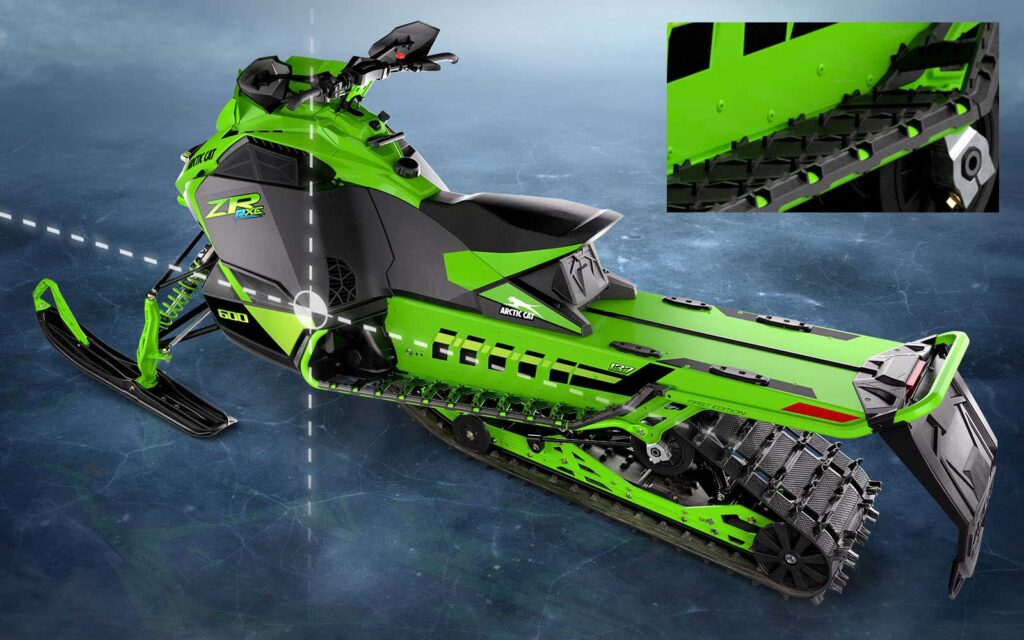
Where’d they lose it?
- The reduction was accomplished using less plastics and parts, lighter seats, a new intake configuration (with a better seal), use of the ADAPT CVT system, shorter and lighter weight heat exchanger and a new belt drive system with less than half the components of the current chaincase system. The engine is also mounted with a long carbon fiber composite Torque Control Link (TCL) with integrated clutch guard which decreases weight and improves engine vibration dampening.
- We’ve already talked about CATALYST’s new low-thermal conductive running boards — a first in the industry — They are lightweight, strong and durable, but the best part, the material prevents snow from sticking, to minimize additional in-the-field ride weight where it matters most.
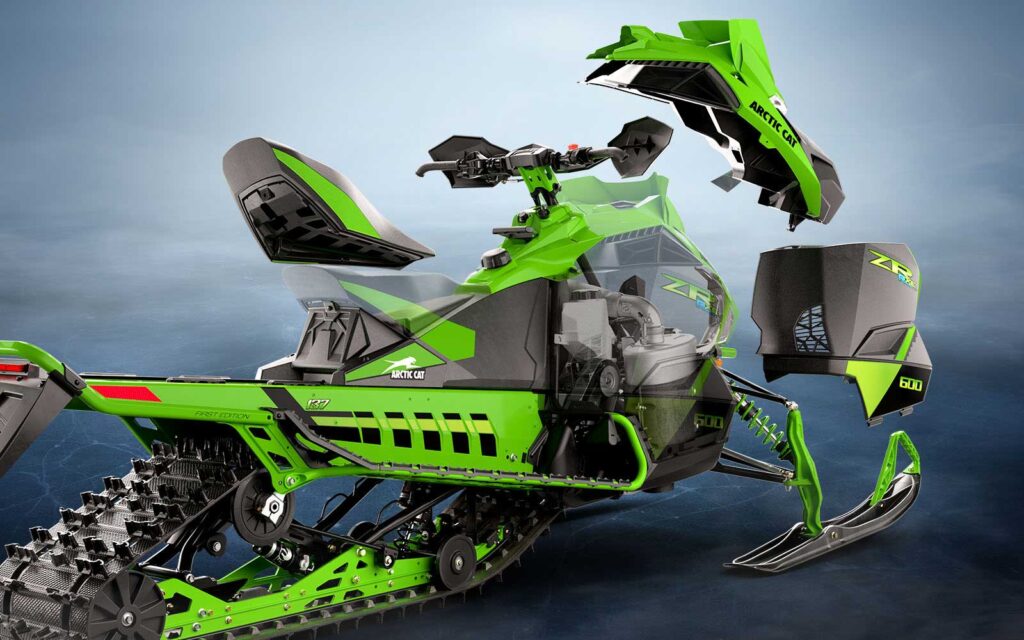
DURABLE AND EASY SERVICING POINTS
An ultra-high-strength steel, one-piece chassis with an aluminum tunnel provides extra support and durability where needed without being bulky. The improved weld joints on the chassis mitigate stress, providing a strong, more efficient design that is easier to service.
The new drive system is belt-driven — unlike the current chaincase — resulting in fewer parts for significant weight reduction, easier serviceability and maintenance, and enhanced performance. It features an adjustable center distance for multiple gearing options and allows for easy belt replacement.
The all-new bodywork panels utilize a toolless design making them easy to remove to access key components such as belts, oil reservoir and coolant. The all-new lightweight seats are easily removeable with a quarter turn to access the battery location quickly.
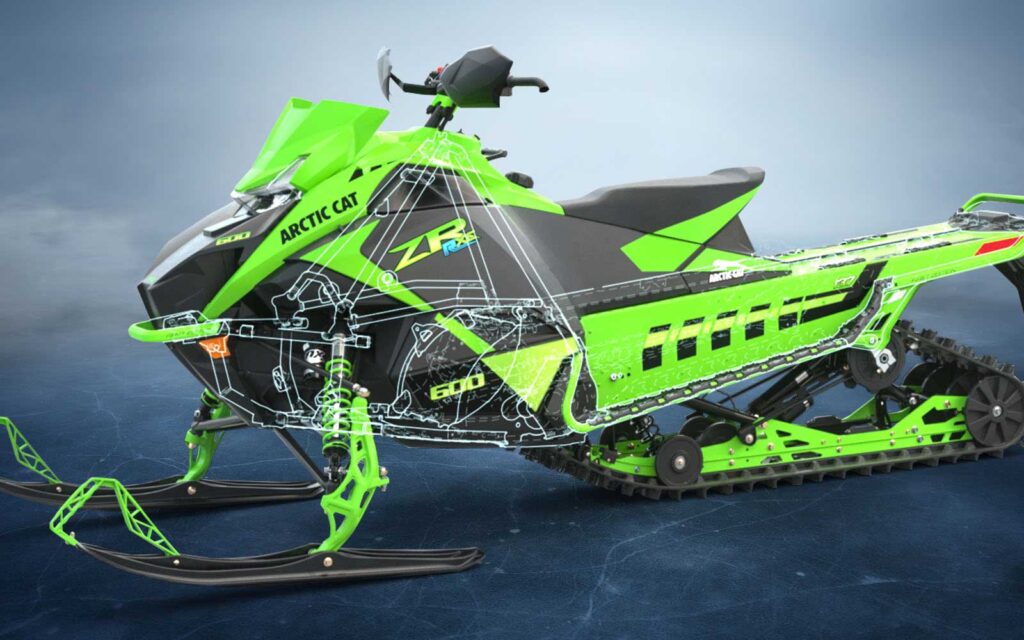
IMPROVED ERGONOMICS
- CATALYST’s ergonomics make the rider one with the sled. Its narrower design, along with the optimized shape of the gas tank, give the rider more area to maneuver in the rider cockpit. The rider will appreciate a new recoil rope centered in the middle of the snowmobile, with revised routing for easier pulling via either hand/arm, and is prone to less rope wear.
- The running board design decreases vibration to the rider’s feet.
- The ergonomics coupled with the centralized design makes for an agile, easily maneuverable sled minimizing rider fatigue and gives the rider more confidence and control.
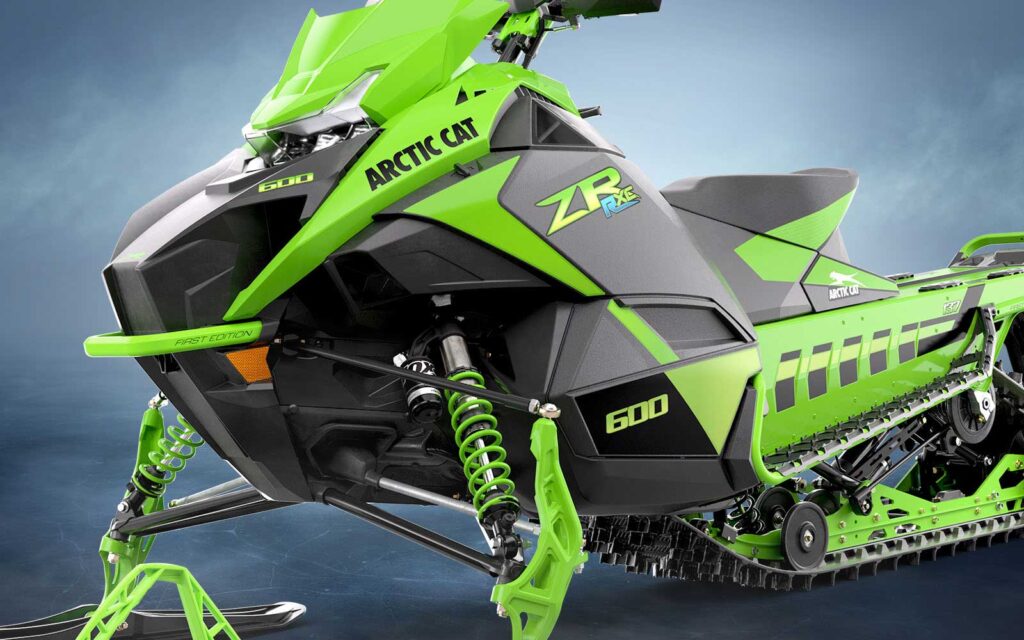
ALL-NEW STYLING
- The aggressive exterior leads state-of-the-art, cutting-edge snowmobile design with an agile, sleek, aerodynamic styling featuring a signature LED headlight setting it apart from the competition much like the auto industry.
- Sliding lap joints were used where possible to provide seamless transitions in bodywork for better fit, finish and appearance.
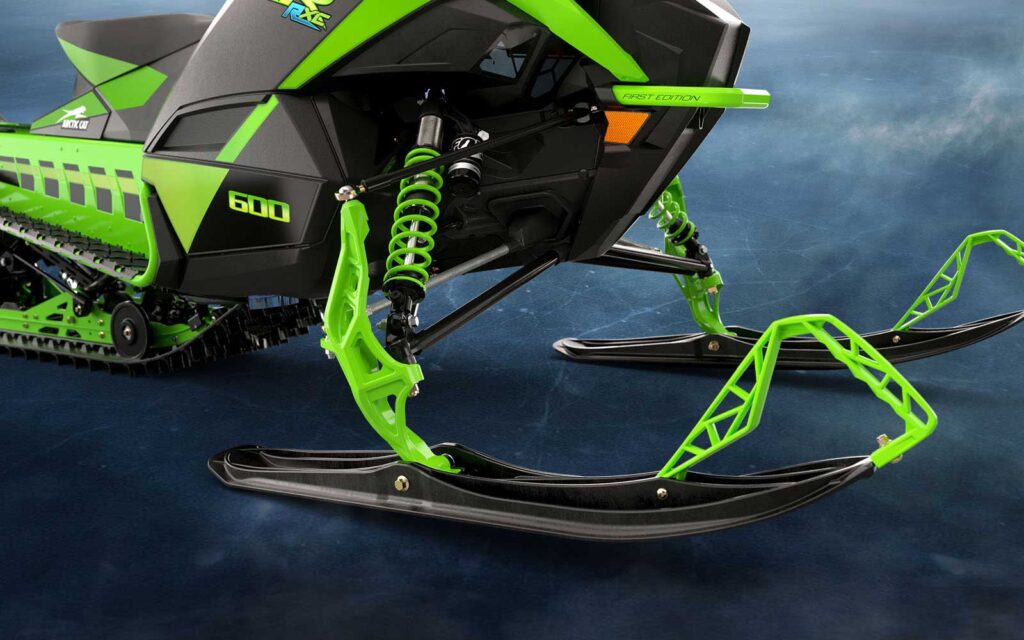
OPTIMIZED SUSPENSION AND STEERING FOR DIFFERENT RIDING STYLES
- The suspension and steering focus between models differentiates where needed but keeps commonality where it makes sense, providing a platform that works for all model segments.
- The Trail and Crossover models have the belt case (remember, no more chaincase) rotated rearward, providing added ground clearance and allowing the front and rear suspension to move rearward for optimal sled balance. The front suspension has geometry changes including upper A-arms that have been lowered and shortened, new lightweight, yet more durable, ball joints and restyled spindles combining to give the rider a more position-reactive snowmobile that hugs the trail while skis stay flat in the corners. Adopted from the snocross track, the Trail and Crossover CATALYST platform models have a ratio steering rack system that feels like power steering, providing a light, but tight feel.
- The Mountain platform has a driver position optimized for floatation and provides a lower center of gravity for improved climbing, carving and descents. With its centralized and constant center of gravity, the platform works in tandem with the rider instead of the rider muscling the sled. The design provides less weight shift to-and-from the skis for a more enjoyable, smooth and agile ride experience. A 36-inch wide ski stance features a longer lower spindle and shortened top of spindle for an increased lower A-arm clearance from the bottom of the ski. This new design provides increased belly pan and track driver clearance through the rough terrain commonly found in the backcountry.
- The mountain platform features centerline vertical steering and was made possible by integrating it with the new intake and exhaust positions within the front portion of the chassis. The new spindle steering geometry, paired with a vertical steering system, and adjustable ski stance reduces steering effort which creates a less fatiguing, better ride experience in the backcountry.
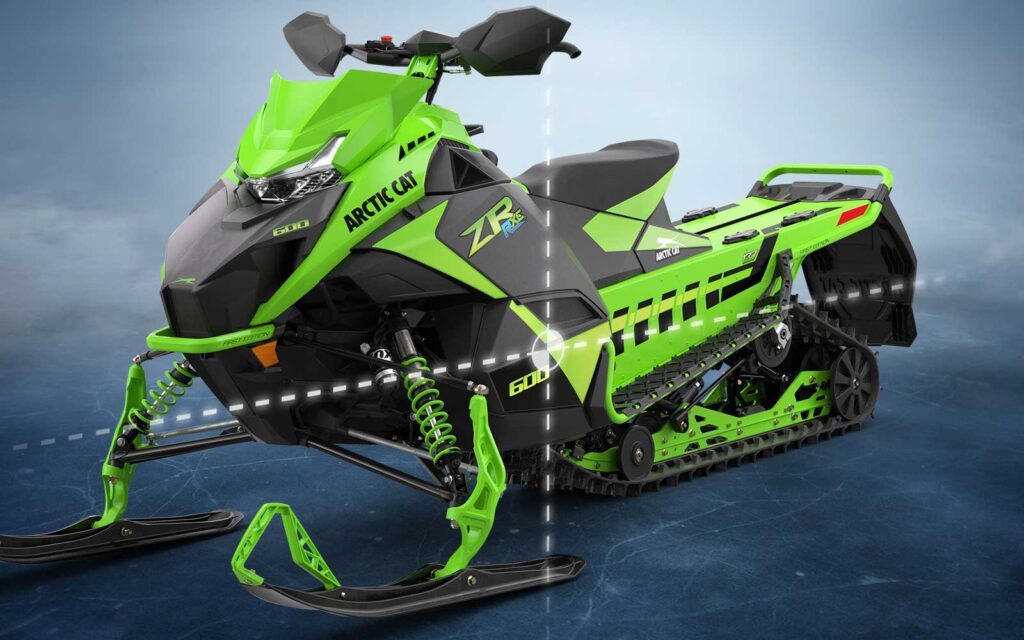
IMPROVED COOLING
- The CATALYST platform utilizes an all-new heat exchanger design with an optimized fin profile to provide additional surface area to improve cooling performance in low snow conditions.
- The trail and crossover models feature an all-new snow flap design enhancing cooling performance for any trail condition.
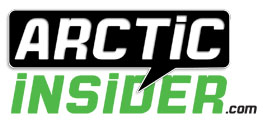


Looks great so far. Keep it coming Cat. Some on here will freak that you did not even show the cost of the machine let alone every detail but that is how they said they were going to do it. A little info at a time.
no 7000 update… major bummer. 🙁
nearly as important, how much bar riser we looking at here?
The 7000 comments make me laugh EVERY time. Ill never live that down. BTW – There is no 7000. 🙂
I’m just here for your entertainment. 🙂
It’s coming and was almost here for 2024 but was axed last minute, should see it for 2025.
Significantly better info here than on the official ac website.
Kale’s the man
😉
As always. It’s both a shame textron doesn’t market anymore and a credit to you for how great of a job you do on this site. Maybe when profits allow for it textron will consider getting back into the marketing game!
Would like to see some info on the rear skid. It seems they are addressing most every other area where the procross has fallen behind.
Thanks for the kudos. AC has done a great job updating their website with CATALYST info. There’s actually some great Q&A with engineering on there that I should share here. One question I remember seeing is pointed to rear skid frame changes. Maybe you asked it, Mark? In a nutshell, the rear skid frame has been revised to better work in harmony with the CATALYST platform. At a certain point, Ill dig into those details and share.
Kale, they really need someone with even a little bit of sled knowledge, or at least a tech background. There are a lot of little typo/wrong words used…
“Calibrated Suspension
The CATALYST platform takes a centralized design ideal for all riding styles and pairs it with legacy suspension and steering to provide a unique experience for each segment.
With ratio steering paired with progressive steering, this innovative design offers a lighter, tighter feel that uses leverage first to mimic the feeling of power steering. ”
“Accessing different sections of your sled is painless with the CATALYST chassis: the plastic panels’ tool-free design allows quick access to components like the belt, oil reservoir and coolant. You can also access the battery with a quarter turn of the seat.”
I get where you are coming from. The statements make sense but you have to read between the lines of engineering explanation to marketing translation. Hopefully I cleaned up some of those areas in this post.
Yeah, I was trying to picture what they mean by a quarter turn of the seat!
And the “legacy suspension” makes it sound like they just slapped in what they had from the procross.
I’m taking that all as poor marketing efforts as opposed to engineering problems.
Kale, I was referring to AC’s website. The quotes are just some of the weirdly worded or just plain wrong things they published today.
They dedicated an entire bullet/page to “calibrated suspension” which doesn’t make any sense (like most of the stuff posted on that page)
I think what we want to hear is… We took the suspension arms and skid from the Snocross and RXC and made it work in this chassis. At least that’s what I want to hear.
Sounds again. Appreciate all the info.
The skid has small changes and slightly different curve on the front half of the rails from the current skid besides the longer front arm as on the R-XC’s since 2015. It’s a whole new ride by the way it is mounted into the Catalyst chassis as it changed the geometry of the skid frame significantly.
Krom,
Have you heard of anyone who’s had the Catalyst 600 engine on a dyno yet? If yes, have the numbers been revealed?
Michman
Can’t wait to ride a demo this winter!!! Hope they add a little purple and get ride of the blue!
Im excited to see the dark blue metallic in person. I have a feeling it will have a purple-ish hue to it in the sunlight. AND, like you, Im excited for demo ride opportunities.
bland… GIVE US BACK SOME GRAY!!!!
Same here! Pretty sure that will be the color I complete my order with.
Kale, any rumblings surrounding the dash technology or who they will partner with like the add on in the past? Lastly, has any information been shared on attachable accessories specifically one that would be comparable to the Polaris Lock and Ride? And to the masses, I agree, I believe that Textron should revisit their relationship with Swanson Russel if they intended to get serious against the polished marketing machine of BRP…
T-Bird – AC has made mention they’ve partnered with GARMIN on a dash display and Im hoping we can get a glimpse of that soon. Ive shared a story or two here regarding the Garmin Tread GPS if you aren’t familiar. (I think Garmin is a great partner) Also, I shared some info in the September, 7 Highlights of CATALYST platform story showing Arctic Cat’s new ATACH tunnel storage system. And to be honest, I haven’t searched out a list of accessories available for ATACH. I owe that to those of you interested.
Kale, from what I can tell nothing has been mentioned specifically to accessories beyond the attachment method, and nothing about a datable second rider seat.
The NS1 gauge has been available for years and is the best in the industry. No need for Textron to partner with anyone!
So far it doesn’t sound like the 600 gained any horsepower. Bummer!!!!
Removing 50 lbs will do a lot more than 2 or 3 hp. Rumblings of 12.5% increase in track horsepower through a much more efficient chassis. That would be huge!
If there are horsepower gains, I don’t expect them to be monumental. Like Jim Ramstad and my wife say, when you drop 50lbs and pair the engine to a more efficient chassis, chances are you’ll free up some usable HP.
maybe a slight bump in powa’… but likely much faster revving.
reliability is a paramount first and foremost, especially for racing 😉
The engineering department. Is planning on. Hand built the first 20 this Saturday ?‼️ Hopefully they’re testing next week ?‼️
Ultra high strength welded steel chassis.
I assume by chassis you mean the front bulkhead and engine mount structure.
I understand the use of steel for strength and stiffness, but it also sounds heavy (I picture in my mind the massive steel bulkhead and engine mount structure from Cat’s sleds of the early 70’s).
In other pictures it is more like a tubular frame, probably Chrome molly steel which is very strong and very light weight. Just a hunch.
The image for the Improved Ergos section suggests a tubular engine mount / suspension attach / pan support structure.
Obviously the front bulkhead has to be fully enclosed so it will be plate steel.
chromoly steel weighs exactly the same as any other steel. “Chrome molly steel” doesn’t’ exist.
Well, not exactly true. Steel alloys containing chromium and molybdenum are typically referred to as chromoloy steel, although it it is sometimes called chrome-moly, cro-moly, CrMo, CRMO, CR-MOLY, etc. So “chrome molly” would seem to be as suitable as any of the others.
no one says, or spells it “molly” not even google ;). Molly is a girl, a fish, a bird, or a party drug.
TBH I don’t see AC using it no matter what you want to call it (even if you like to call it 4130) It’s expensive, and doesn’t have much of any strength benefit over 1020 on a welded structure like this (unless you heat-treat the assy after welding)
Accidentally submitted the last post before saying my guess is they will use HSLA steel because it’s what they use on the dirt side.
A Noni Moose – Correct. Anything in front of the tunnel (“front bulkhead” area) are what Im referring to.
Judging by the image posted in your overview, it looks like Cat re-engineered the “pyramidal” frame to avoid further litigation from BRP.
The adjustable center distance of the belt drive is interesting, I’d like to hear how that works or see it.
The catalyst is sounding better and better, cat really went all out on this one. I like that they kept steel for the frame.
Very interesting!
The changes to the cooling system will hopefully prevent ice from accumulating over the Riot’s heat exchanger. I also like the idea of making the sled easier to handle. While I like the stability of the ProCross in corners, that works against me at times. I’d like to see what difference the belt -vs- chain difference makes.
Lets see a Mountain Sled version and what a larger engine than the 600? better do something fast to keep up in the mountain riding world or Cat is going to start losing even more customers.
Justin Smith – A mountain version of CATALYST has already been released and shown on these pages (type CATALYST into search function) as well as Arctic Cat’s website. As far as a bigger bore engine option…its coming.
Steel bulkhead, think pre 97 ZR
Centralized mass, think 03 Firecat.
With Brian Sturgeon running belt drive in the early 90’s with great success, one has to wonder why did it take so long for it to make it to production Polaris and cat sleds?
Jeff – At the Hay Days media event this year, one of the magazine editors asked how long CATALYST has been in development. The answer made complete sense, but one setting most in the room back on their heel…”20+ years” was the answer.
Thinking about the answer, and furthering your point, Centralized Mass isn’t a new concept, but its one that is constantly being evolved and tested. In my mind, AC spawned the first marketing focus on centralized mass with the Laydown Engines debuting on the 2002 Sno Pro and further finding their way to the 2003 Firecats…like you mention.
As far as Belt Drive…Im sure someone from engineering could answer this question more directly, but I sat in a few meetings over the years (starting in the Firecat days) and the discussion of belt drive seemed to end when talking about added cost. A lot has changed since then, and Im guessing it was revisited when the opportunity to build an all-new platform focusing on lightweight and performance arose. And here we are…20+years. 🙂
20+ years would be correct. its 20 years and few weeks to the day that almighty REV made the duluth debut. at the time, you didn’t know it, but seeing it at duluth for first time was probably the greatest day in all of snowmobiling history.
Kale,
Do you know if they will be offering ATAC suspension in the new models?
I don’t know that answer. I suspect you’ll see ATAC models offered in the 2024 line-up.
It is crazy exciting on how much has changed! My Riot is new, but this gets a guy thinking!! Light and nimble is so…. much fun. 4-strokes are just too heavy.
I agree Light and Nimble is fun! One of the main reasons I love the hell out of my Blast ZR 121. (Riding it makes you laugh when throwing it around) That said, I do think the 2023 Thundercat with Electronic Power Steering (EPS) is THEE ultimate high mileage 4-stroke trail machine. Hard charging in twisty wooded trail sections without EPS and all that power for endless miles can wear a fella out quick. The addition of EPS eliminated about 99% of fatigue for those types of riders…steering through corners is now effortless.
I was seriously considering upgrading from my 1986 Pantera but I guess I’ll keep ditch banging with the Catillac as I’m pretty sure the 440 will rip this 600. Now, if it was a 950…….
Nice arcticle Kale.
If yer 86 Pantera had a 950 it would definitely beat the new 600…
Kale, Hope your planning to get to the factory in the next few days for some sno pro pics and maybe a few shots of the limited number of Catalyst sleds that will be assembled for the top race teams and the demo rides coming up.
Kale, Will there be any chance of AI edition complete with a muff pot to store roller dogs, a larger riser and extra storage for sardines?
All the parts are on the shelf…just waiting on my demo! Lol
I really think Cat has hit a home run with this package (based on what we know so far). However, who was in charge of the decal package? Seems extremely lack-luster for an otherwise super exciting new phase for A/C. I hope what we have been exposed to so far is NOT what we will actually see for the 2024’s. I get it, nothing a wrap can’t fix. Just seems like a missed opportunity.
The lack of decals is very S** D** like, actually the placement and layout is almost identical.
Believe it or not, there’s more vinyl (graphics) on those body panels than you realize. Are they “Hotweels” enough for Arctic Cat enthusiasts? I guess time will tell. Pierrelacat hit nail on the head…graphics and designs will gradually increase year-over-year.
I hope to God Cat doesn’t give Yamaha all this tech!!! the catalyst should not have any Yamaha badging on it!!! Let them make their own sled and this 10.4 gas tank is a crying shame. Once again, I have been fighting for years to get a bigger gas tank up here in Canada we have 105 mile distances and fuel economy has been actually quite good on my 22 ZR 8000 however, deep snow in Trail will eat that up like it’s free! They should put a 13 gallon tank on it and anybody that wants it lightweight. Just fill it up to 9 gallons! As far as the bland graphics go, they do that all the time on a brand new release, splash, fancier stickers on it in 2025/2026!!!
I actually hope Cat and Yamaha continue their relationship. It is only helping both companies sell sleds and gain market share. If they split up Yamaha will be done with sleds which will not be good for the industry and Cat will lose one of the best engines on the snow…the 998.
I didn’t realize the tank was smaller – not good as we regularly stretch the range on our tanks. Guess we could carry some but who wants all that weight on the tunnel?
I also hope Yamaha continues, otherwise they’ll probably team up with someone else. I’d guess they’ll do with doo has done and have a slightly different chassis for the 4 strokes.
I am all in on a 2025 catalyst 880 or 900 whatever engine they build it’ll crush the red and yellow camps
When it comes to decals, less is more. Cat always seems to get carried away with their graphics package. The mostly black with a few splashes of green color combo on the catalyst is the best looking sled Cat has had in years.
Curious to learn if the new platform has electric start. Having electric start and losing 10% of its weight would be quite a feat.
Yes it will have E start. It has a battery placement in the back of the tank.
wrong again… E start is not going to be standard on every model
Curious if the 998 will be in the catalysts?
Thinking the Yamaha motors are to big for the chassis. At this point. Mite have to go back to a 2-cylinder.
Mtn guys want a turbo you can do all the BNG’s you want and new this and new that but until you step up and out a factory turbo on at least an 850 the mtn folks will ride another brand been riding cats for 30+ years won’t buy another till they get their s!!? .together and compete with the other two !!!!